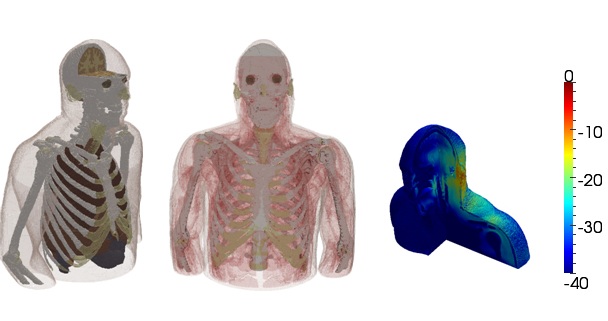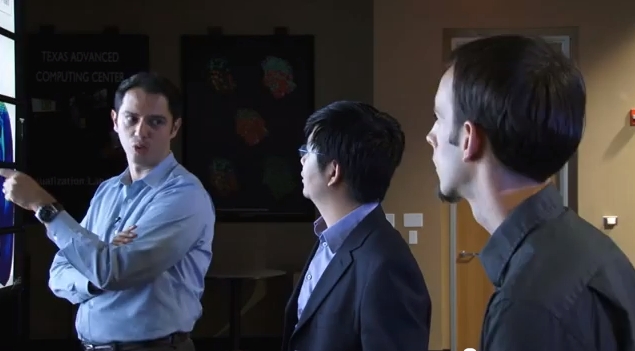Digital AustinMan Created to Study Cell Phone Radiation

This Behind the Scenes article was provided to LiveScience in partnership with the National Science Foundation.
To study the effects of cell phones on the human body, researchers have created a virtual body that is unmatched in its richness of detail.
"AustinMan" is a virtual receptacle for radiation, an ultra-high-resolution, three dimensional map of the human body; he is helping researchers understand more about the potential health-related effects of wireless devices.
He was born of a National Science Foundation grant, the hard work of University of Texas at Austin researchers and students, as well as a publicly available, extremely high-resolution scan of the human body made possible by a man on death row who donated his body to science.
Overall, AustinMan contains more than 100 million voxels (three dimensional versions of pixels) that interact with one another during virtual cell phone calls — experiments designed to predict how different parts of our bodies absorb electromagnetic power.
Thermal effects
The danger of cell phones is much discussed and debated, but scientists still have many questions about cell phone use and health concerns such as cancer.
Get the world’s most fascinating discoveries delivered straight to your inbox.
"What is well-established is the thermal damage," study researcher Ali Yilmaz, an assistant professor at the University of Texas at Austin, said. "We know that cell phones radiate electromagnetic power and, just like your microwave ovens, if you turn up the power enough you are going to heat and cook tissue. The open question is how much is too much?
"These simulations that we are doing are a step in the direction of identifying these limits and answering how much is safe, how much is not," Yilmaz said.
Even at lower power levels, microwaves have been linked to tissue damage and other negative effects. In animals, the effects range from fetal defects to changes in the leakiness of capillaries in the brain. To protect people from these heat effects, regulatory bodies have issued safety standards that restrict our exposure to microwave fields.
"The standards require that the microwave power absorbed by our bodies due to a wireless device, quantified in terms of the specific absorption rate, be smaller than the specified limit to keep thermal damage at bay," Yilmaz said. "The problem is, we don't know precisely how much power is absorbed."
Extreme simulations
To estimate the absorbed power accurately, the researchers use advanced algorithms on supercomputers. Here's where AustinMan comes in.
He represents the human anatomy through something akin to a virtual Lego body composed of extremely small, one-millimeter cubed blocks. The researchers worked with anatomists to transform high-resolution image slices into computational maps of the body's tissues.
Previous models had included only a handful of tissue types. The current model contains 30 types of tissues, each with unique electromagnetic properties. (The image slices came from the U.S. National Library of Medicine's Visible Human Project. In the 1990s, a Texas death row inmate donated his body to science; it was scanned to create the images.)
The team's extreme simulations using AustinMan would be impossible using traditional computing methods and software. Even with efficient algorithms, on an ordinary desktop computer each simulation would take about five years of continuous execution. Crunching the numbers on the National Science Foundation-sponsored Ranger supercomputerat the Texas Advanced Computing Center, however, Yilmaz and his team can perform the simulations in less than six hours.
"The supercomputing infrastructure at Texas Advanced Computing Center is fundamental to this work," Yilmaz said. "The simulations we're performing on Ranger are some of the biggest and most complicated bioelectromagnetics simulations ever."
Initial Results
The team's initial results with AustinMan illustrate the importance of having high-resolution body models. In a recently submitted paper, Yilmaz and his students showed that low-resolution models can under- or over-estimate the power absorbed by the skin, the cornea, the cerebrospinal fluid and brain matter by up to 50 percent.
These simulations will not answer the question of whether cell phones are dangerous per se — much about the dynamics of cancer and other health effects is still a mystery to scientists. But they represent one of the best ways to probe and quantify the thermal effects of nearby wireless devices.
They also act as virtual test chambers to aid the design of better antennas and wireless devices that operate safely near, on, or in the human body.
Examples of questions the team can answer: "Can we increase the radiated power 100 times to get much better video connectivity? How safe is it to do that? If we can't increase the power, then can we design antennas that minimize the power absorbed by our bodies and maximize the power radiated away?"
"We are developing cutting-edge simulation technology that can help answer these questions," Yilmaz said.
Editor's Note:The researchers depicted in Behind the Scenes articles have been supported by the National Science Foundation, the federal agency charged with funding basic research and education across all fields of science and engineering. Any opinions, findings, and conclusions or recommendations expressed in this material are those of the author and do not necessarily reflect the views of the National Science Foundation. See the Behind the Scenes Archive.




